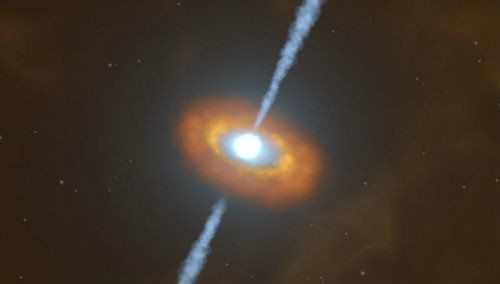Supermassive Black Hole Diets Affect Brightness Of Active Galactic Centers

Black holes are monsters of the cosmos. They gobble up everything in their proximity and leave nothing to escape, not even light. Same is the job of their elder siblings that are much bigger in size and are found at the heart of active galaxies.
As per scientific estimates, the elder ones, dubbed supermassive black holes, are the biggest among all varieties of voids. They can weigh as much as billions of suns and are known to feed on material from farther reaches with their intense gravitational tug. These cosmic devourers do not give away any light of their own just like their cousins, but the material they pull often shines brightly, helping scientists deduce the presence of a humongous black hole in the region.
Interestingly, the light of material gobbled up by a supermassive black hole sitting at the center of a galaxy or active galactic nucleus (AGN) varies a lot. This variation has been noted on a range of occasions, but the exact physical mechanism causing this wasn’t determined, leaving astronomers puzzled.
“The light emitted by the material that is falling in the black hole (its brightness) changes a lot over time, without a stable pattern,” Paula Sánchez-Sáez from the University of Chile said in a statement. “Although we know that it varies, we have not yet been able to determine the reason.”
Stars and galaxies without active nuclei remained constant in brightness but those with AGN witnessed regular rise and fall in brightness, with no major property to be linked.
To solve the cosmic mystery, Sánchez and colleagues analyzed the behavior of as many as 2,000 objects studied as part of two different surveys named Sloan Digital Sky Survey (SDSS) and QUEST-La chair AGN variability survey.
"In this study, we tried to answer the question of how the variability of these connects with the physical properties of the supermassive black hole," Sánchez added in the statement.
The SDSS survey provided an idea of the accretion rates of the black holes, while the QUEST-La chair AGN survey provided insight into the variability of light in their respective AGNs.
On comparing the two datasets with suitable light curves, the team came to the conclusion the only property that could justify this variability is the rate at which the black hole eats material in its vicinity.
“This is nothing but how much material is falling into this supermassive black hole,” study co-author Paulina Lira explained. “So if it is on a diet, or if it is swallowing a lot or if it does not fit anymore in his mouth...that will determine if they [material brightness] vary much or little.”
The team even noted the less a black holes gobble, the more the brightness of its AGN would vary.
Moving ahead, the researchers plan to expand the work and understand the time scales of active galactic nuclei variability. However, to measure that property they would at least need a decade worth of data.
The study titled, “The QUEST–La Silla AGN Variability Survey: Connection between AGN Variability and Black Hole Physical Properties,” was published in the Astrophysical Journal.
© Copyright IBTimes 2024. All rights reserved.





















